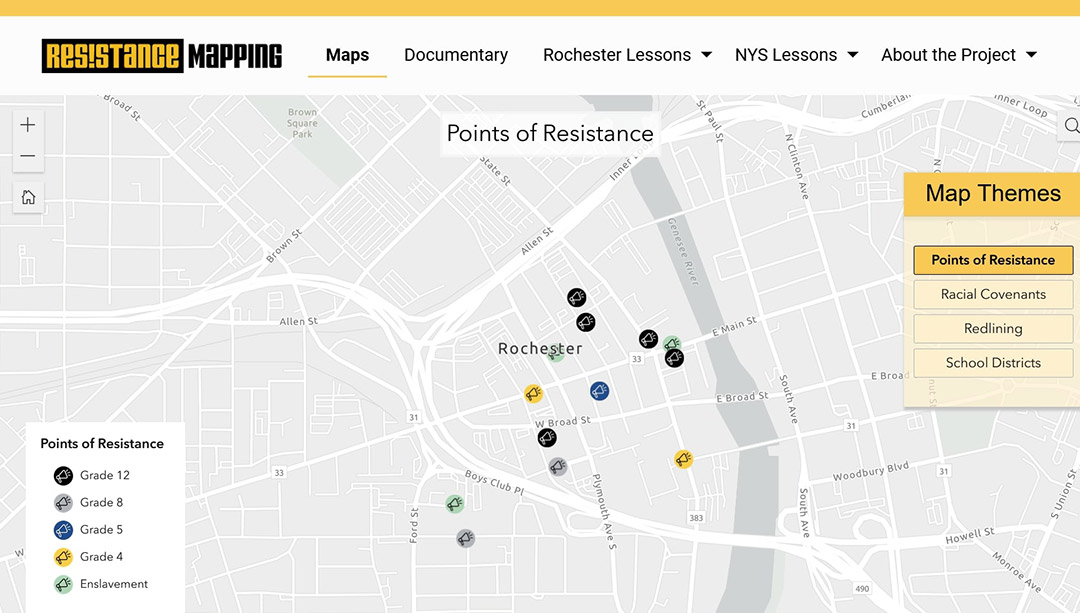Resistance Mapping project provides a digital home for antiracist educational resources for K-12 educators
The project is a collaboration between the Antiracist Curriculum Project, RIT, and UR
Max Schulte/WXXI
The curriculum developed as part of the Resistance Mapping project draws from primary sources from both past and current events. This photo from a Black Lives Matter protest in 2020 in Rochester is one example of the sources shared as part of the pre-prepared lesson plans.
In what ways does a history of racist policies impact and influence our experiences today? How can educators teach their students about the historic impacts of racism on their own communities? These questions, and more, can be answered by exploring the new, open access bank of educational resources called Resistance Mapping.
Resistance Mapping is a local, collaborative digital humanities project focused on how Monroe County, N.Y., has been shaped by histories of institutional racism and collective community resistance. The project’s resources are tailored to educators working with students in grades 2-12 and was built on a preexisting foundation of work by a local organization called the Antiracist Curriculum Project (ACP).
Provided image
A screenshot of the Resistance Mapping interactive map which shows sites of resistance throughout the Rochester region.
As part of a three-year grant from the PathStone Foundation, scholars and students affiliated with RIT’s humanities, computing, and design program and the University of Rochester’s Digital Scholarship at River Campus Libraries helped the ACP expand its resources and create a website to host the educational content. This year, as part of the final phase of this grant work, the group completed the website and began sharing it in educator trainings to show local teachers how to use Resistance Mapping in their classrooms.
The collaboration began when Whitney Sperrazza, assistant professor in RIT’s College of Liberal Arts, connected with Shane Wiegand, co-executive director of the ACP. Wiegand shared the organization’s need for a robust website, and Sperrazza helped form connections within the RIT community and beyond to meet that need.
“From the beginning, our goal has been to uplift the antiracist work that’s already being done in the Rochester community. This is a project about Rochester, and it would have felt irresponsible if we hadn’t ensured that this was really community-driven and community-owned,” said Sperrazza. “We made a lot of decisions from the start to ensure that the back-end development and updates were as plug-and-play as possible so that Shane, Kesha, and their team could eventually take complete ownership of the project.”
The Resistance Mapping website functions as a living, digital archive that documents the history of racist housing and other place-based policies in Rochester and the surrounding region. The materials explore how Rochester’s current segregation emerges from that history and confronts these realities through stories of past and present activism, along with creative imagined possibilities for our community’s future.
Some of the resources available on the website include an interactive map of Greater Rochester showing sites of resistance, a series of lesson plans—complete with teacher instructions, student handouts, and slide decks—and a documentary about the history and legacy of residential segregation in Greater Rochester. While the bulk of the content centers on the Rochester region, the project has expanded to include other regions throughout New York state.
Kesha James, co-executive director of the ACP, worked as a teacher in the Rochester City School District for 14 years. After attending a training led by Wiegand, where she was introduced to an early version of the antiracist curriculum developed by the group, James became involved with the ACP part-time. She began working full time as co-executive director in January 2021.
During trainings she has led with educators so far, James said that the response to the Resistance Mapping material has been overwhelmingly positive. She added that teachers have also expressed gratitude for making these materials available for free use in the classroom.
“What I hear a lot is that they just needed resources. They needed something they could build off of, because a lot of teachers don’t have time to build the extensive curricular units we’ve done. When you’re teaching seven subjects in one day, it’s not feasible,” said James. “Oftentimes you’ll find really great resources, but they’re password protected or you have to pay in order to view it. With this, it’s free and open to the community. We don’t want to gate keep any of this information.”
Making the resources free and available to anyone with internet access has already resulted in positive change in the local community. James shared one example of how the content resonated with a local high school senior who found the website while working on her senior capstone project.
“I don’t even know how she found the website, but she taught herself the curriculum and reached out to us. She wanted to do her capstone work on exclusionary zoning in Henrietta, so we connected her with some community members and they did a bunch of research together,” said James. “At the end of her project, she presented her work at a Henrietta town board meeting and got them to actually change the zoning for some new apartments.”
Making the materials organized, accessible, and searchable was vital to the success of this project. Rebekah Walker, digital humanities and social sciences librarian at RIT, and Blair Tinker, GIS specialist for the Digital Scholarship Lab at UR, used their unique expertise to help facilitate and manage the technical aspects of the project. Now that the grant work is coming to a close, Walker and Tinker have shifted their focus to ensuring the ACP can take ownership of the site and continue their work.
“My title isn’t technically ‘digital scholarship librarian,’ but I feel that title speaks to my role on projects like this. You need scholars who are generating content, and then you need people like Blair and I who are on the back end sort of pushing the boulder up the hill,” said Walker. “We’ve had some trainings with Shane and Kesha in the last few months so they can ask us questions and go through the back-end processes because we wanted to make sure that, once they have new materials that they want to upload, they won’t have any issues holding them back.”
Over the next few months, the Resistance Mapping team plans to transition ownership and maintenance of the website to James, Wiegand, and the ACP.
For more information, go to the Resistance Mapping website and explore the project’s resources.








